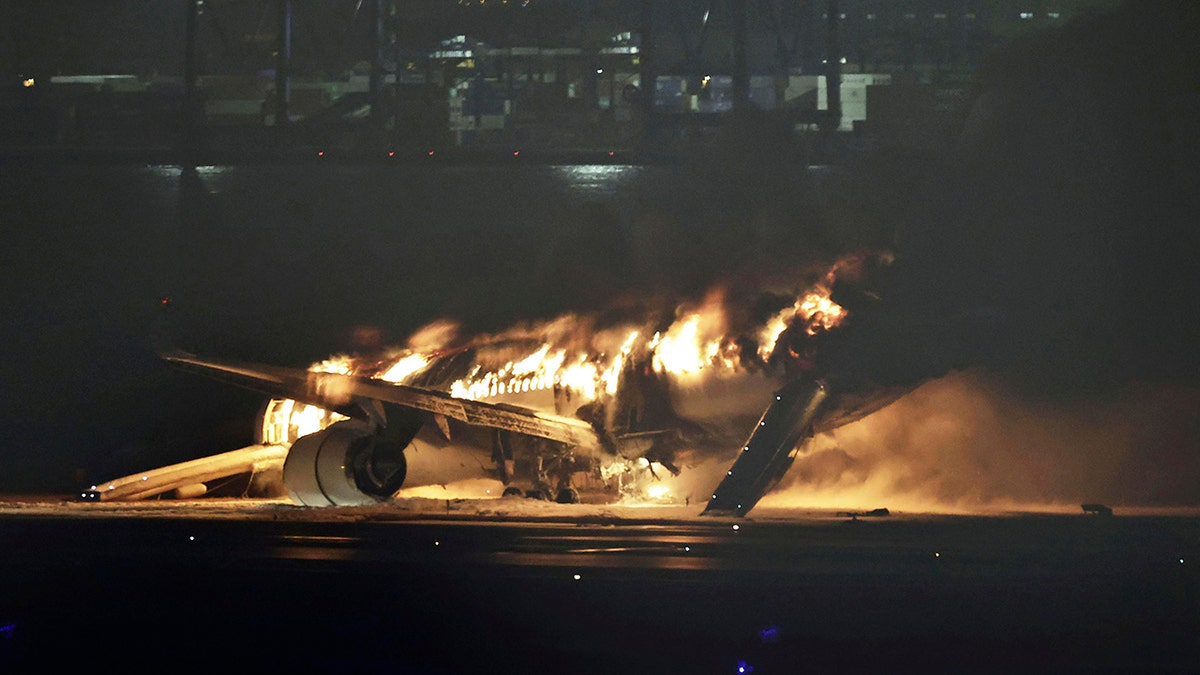Japanese Airlines jet erupts in flames at Tokyos Haneda airport
A Japanese Airlines passenger plane with hundreds of passengers burst into flames at Tokyos Haneda airport following a possible collision.
Japanese officials have launched two separate probes into Tuesday’s deadly plane crash where five people died after a passenger jet collided with a Coast Guard turboprop at a Tokyo airport and burst into flames.
Transport safety officials are focusing on communication between air traffic control officials and the two aircraft to determine what led to the collision at Haneda airport. Meanwhile, police began a separate probe into possible professional negligence, according to The AP.
Japan Airlines Flight 516, an Airbus A350-900, touched down on a runway at Tokyo's Haneda airport and collided with the Coast Guard’s flight MA-722, a Bombardier Dash-8.
JAPAN AIRLINES PLANE BURSTS INTO FLAMES AFTER COLLISION AT TOKYO'S HANEDA AIRPORT, LEAVING 5 DEAD

Officials look at the burnt wreckage of a Japan Airlines passenger plane on the tarmac at Tokyo International Airport at Haneda in Tokyo on Jan. 3, 2024. Two probes have been launched into the deadly plane crash where five people died. (Richard A. Brooks / AFP)
The Airbus burst into flames and then came to a stop while spewing gray smoke. Miraculously, all 367 passengers and 12 crew were evacuated safely by sliding down emergency chutes.
However, the collision killed five of the six crew onboard the Dash 8. The captain escaped the wreckage but was badly injured.
Japanese authorities said on Wednesday that the passenger jet was given permission to land, but the smaller plane was not cleared for take-off, based on transcripts of conversations with the control tower, according to Reuters.

Firefighters work at Haneda International Airport after Japan Airlines' A350 airplane caught on fire in Tokyo, Japan January 2, 2024. Two probes have been launched into the deadly plane crash where five people died after the passenger jet collided with a Coast Guard turboprop. (REUTERS/Issei Kato)
PASSENGERS OF JAPANESE PLANE SPEAK OUT AFTER FIERY COLLISION LEAVES 5 DEAD: 'IT WAS HELL'
The transcripts appeared to show the Japan Airlines plane had been permitted to land but that the Coast Guard aircraft had been told to taxi to a holding point near the runway. The Airbus had flown from Shin Chitose Airport, near the city of Sapporo, to Haneda
An official from Japan's civil aviation bureau said there was no indication in those transcripts that the Coast Guard aircraft had been granted permission to take off.
The captain of the Coast Guard plane said he had entered the runway after receiving permission, a Coast Guard official told Reuters, while acknowledging that there was no indication in the transcripts that he had been cleared to do so.

The Japan Airlines plane on fire on the runway of Haneda airport on Jan. 2, 2024 in Tokyo, Japan. Transport safety officials are focusing on communication between air traffic control and the two aircraft while police are probing possible professional negligence. (Kyodo News via AP)
The Japan Transport Safety Board (JTSB) said safety investigators plan to interview the pilots and officials from both sides, as well as air traffic control officials, to find out how the two planes simultaneously ended up on the runway.
CLICK HERE TO GET THE FOX NEWS APP
The fire is likely to be seen as a key test case for airplane fuselages made from carbon-composite fibers — featured on the A350 and the Boeing 787 — instead of conventional aluminum skins.
"This is the most catastrophic composite-airplane fire that I can think of. On the other hand, that fuselage protected (passengers) from a really horrific fire — it did not burn through for some period of time and let everybody get out," safety consultant John Cox said.
In a statement, Airbus said that it was sending a team of forensic experts to Japan to assist authorities with their investigations. It said the exact cause of the collision has yet to be determined.
The airline manufacturer said the passenger jet involved in the accident, MSN 538, was delivered to Japan Airlines from the production line on Nov. 10, 2021 and was powered by Rolls-Royce Trent XWB engines.
Reuters and the Associated Press contributed to this report.






















